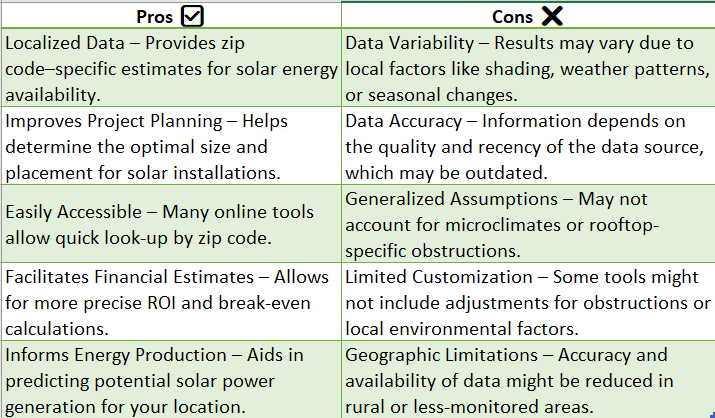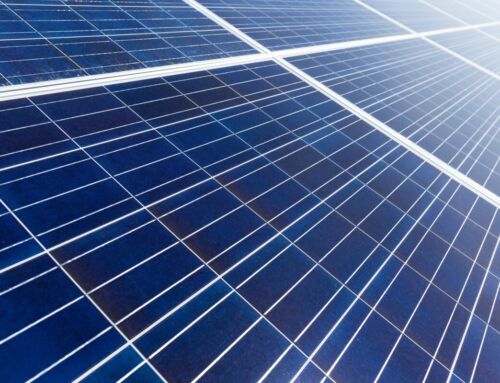Understanding Peak Solar Hours by Zip Code
Understanding peak solar hours by zip code is essential for anyone considering solar energy. These hours indicate when sunlight is most intense, allowing solar panels to operate at maximum efficiency. Knowing your area’s peak solar hours can significantly enhance energy production and savings. Why Peak Solar Hours Matter- Maximize Efficiency: Optimize solar panel placement and angle to capture the most sunlight.
- Cost Savings: Efficient energy capture leads to lower electricity bills and a quicker return on investment.
- Environmental Impact: Reduces reliance on fossil fuels, promoting a cleaner environment.
Why Peak Solar Hours Vary by Zip Code
Understanding the variation in peak solar hours by zip code is crucial for anyone considering solar energy. These differences are primarily influenced by geographical location, climate, and local topography. Areas closer to the equator, like sunny California, generally receive more sunlight throughout the year compared to northern regions like Seattle, which is often cloud-covered. Geographical Influence- Latitude: Proximity to the equator results in more direct sunlight.
- Elevation: Higher altitudes receive more sunlight due to a thinner atmosphere.
- Proximity to Water: Coastal areas may have more cloud cover, affecting sunlight availability.

Thinking about solar energy? See how it can lower your bills and elevate your home’s efficiency. Get Your Free Estimate at NewSolar QuotesWhy It Matters Knowing your zip code’s peak solar hours helps in making informed decisions about solar panel installation. More peak hours mean greater energy generation potential, leading to significant savings on electricity bills. Additionally, understanding these variations aids in optimizing solar panel placement and angle for maximum efficiency, enhancing cost efficiency and reducing your carbon footprint. Whether in a sunny or cloudy area, understanding local solar potential is key to maximizing your solar investment.
How to Calculate Peak Solar Hours in Your Zip Code
Knowing your area’s peak solar hours is essential for optimizing solar panel efficiency. These hours indicate when sunlight is strong enough to produce maximum solar energy, helping you make informed energy decisions. To determine peak solar hours, start with online solar calculators that use your zip code and historical weather data to provide estimates. For example, sunny California might offer up to 5.5 peak hours daily, while Seattle may see around 3.5 hours. Here’s how to get started:- Use Online Tools: Websites like the National Renewable Energy Laboratory provide calculators that estimate solar potential based on your zip code.
- Check Local Weather Patterns: Understanding local weather trends can refine your estimates, as cloudy regions typically have fewer peak solar hours.
- Consult with Solar Experts: Local solar installers can offer insights specific to your location, ensuring accurate data.
The Importance of Knowing Your Zip Code’s Peak Solar Hours
Understanding your zip code’s peak solar hours is crucial for optimizing solar energy use. These hours, when sunlight is most intense, allow for maximum electricity conversion. By knowing your specific peak solar hours, you can tailor your energy consumption to these times, ensuring your solar panels operate at peak efficiency. Consider the difference between sunny California and cloudy Seattle. In California, longer peak solar hours mean more opportunities to harness solar energy effectively. By aligning high-energy tasks, like running appliances or charging electric vehicles, with these hours, you can achieve significant cost savings. Key Benefits of Knowing Peak Solar Hours:- Maximized Energy Production: Ensures solar panels generate the most energy when needed.
- Cost Savings: Reduces reliance on the grid, lowering electricity bills.
- Environmental Impact: Decreases carbon footprint, promoting sustainability.
Maximizing Solar Energy Efficiency by Zip Code
Understanding peak solar hours is crucial for maximizing the efficiency of solar panels. These hours, which vary by zip code, represent the time when sunlight is most intense, allowing solar panels to generate the most electricity. Knowing your local peak solar hours helps optimize energy production, enhance system design, and improve return on investment. Why Peak Solar Hours Matter- Optimize Energy Production: Align energy use with peak hours to minimize grid reliance.
- Enhance System Design: Adjust panel placement for optimal sun exposure.
- Improve ROI: Maximize energy output for better financial returns.
- Research Local Data: Use online resources or consult local solar experts.
- Monitor Energy Usage: Adjust consumption patterns to align with peak hours.
- Consult Experts: Collaborate with professionals to design an efficient system.
Tools to Determine Peak Solar Hours by Zip Code
Understanding peak solar hours is essential for anyone considering solar energy solutions, as these hours indicate when sunlight is most intense and can be effectively harnessed for energy production. To determine these hours for your specific location, several tools are available that simplify the process by using your zip code. The National Renewable Energy Laboratory’s (NREL) PVWatts Calculator is a popular tool that provides detailed information about solar potential, including peak solar hours, based on your zip code. It’s user-friendly and offers a comprehensive overview of the solar energy you can generate in your area. Another valuable resource is Google’s Project Sunroof, which estimates your home’s solar potential using satellite imagery. By entering your zip code, you can discover the number of peak solar hours your location receives and receive personalized recommendations for solar panel installations. This tool is particularly beneficial for homeowners aiming to maximize their solar investment.- Benefits of Using These Tools:
- Accurate Data: Provides precise, location-specific information.
- Cost-Effective Planning: Facilitates informed decisions about solar panel investments.
- Environmental Impact: Promotes renewable energy use through clear insights.
Seasonal Changes in Peak Solar Hours by Zip Code
Understanding the fluctuation of peak solar hours throughout the year is crucial for anyone considering solar energy. These hours, indicating when the sun is most potent, vary by location and season, affecting solar panel efficiency and energy savings. For example, sunny California experiences different peak solar hours compared to cloudy Seattle, emphasizing the need for location-specific solar solutions. Why is this important? Knowing your zip code’s peak solar hours aids in making informed decisions about solar panel installation and energy use. Here are some benefits:- Maximized Energy Production: Aligning energy usage with peak solar hours enhances solar power harnessing.
- Cost Savings: Understanding these hours can reduce electricity bills by increasing reliance on solar energy.
- Environmental Impact: Efficient solar usage reduces your carbon footprint.
- Research Your Zip Code: Use online tools for detailed solar hour data.
- Consult with Experts: Get insights tailored to your location.
- Monitor Seasonal Changes: Adjust energy usage as peak hours shift.
Impact of Peak Solar Hours on Solar Panel Performance
Peak solar hours by zip code are crucial for optimizing solar panel efficiency. These hours indicate when sunlight is most intense, directly affecting energy generation. Living in an area with high peak solar hours means your panels can produce more electricity, reducing grid dependency and lowering energy costs. Why Peak Solar Hours Matter:- Maximized Energy Production: More sunlight during peak hours boosts your panels’ energy output.
- Cost Efficiency: Understanding your area’s peak hours helps optimize panel placement and angle for maximum efficiency.
- Environmental Impact: Efficient solar energy use reduces your carbon footprint, promoting sustainability.

Comparing Peak Solar Hours Across Different Zip Codes
Understanding peak solar hours by zip code is crucial for anyone considering solar energy. These hours, indicating when sunlight is most intense, vary widely based on location. For example, a zip code in sunny Arizona might enjoy more peak solar hours than one in cloudy Seattle, affecting everything from the size of the solar panel system needed to potential electricity bill savings. Why is this important? Knowing your area’s peak solar hours helps in making informed decisions about solar panel installation. Here are some key benefits:- Optimized Energy Production: More peak hours mean more energy generated, maximizing your solar investment.
- Cost Efficiency: Understanding local solar potential helps choose the right system size, avoiding unnecessary expenses.
- Environmental Impact: Efficient solar use reduces reliance on fossil fuels, contributing to a greener planet.
Using Peak Solar Hours to Plan Your Solar Installation
Understanding peak solar hours by zip code can significantly ease the process of planning a solar installation. These hours represent when sunlight is most intense, allowing solar panels to generate maximum electricity. This knowledge is crucial for optimizing your solar investment and ensuring your system’s efficiency. Why Peak Solar Hours Matter:- Maximize Efficiency: Aligning your solar panel installation with peak solar hours ensures optimal sunlight capture, enhancing energy production.
- Cost Savings: Efficient energy capture translates to lower electricity bills, making your solar investment more profitable.
- Environmental Impact: Efficient systems reduce reliance on non-renewable energy, promoting a greener planet.
FAQ
-
What are peak solar hours?
They measure the average number of full sun hours per day a location receives. -
How do I find peak solar hours for my zip code?
You can use tools like PVWatts, the National Renewable Energy Laboratory (NREL) databases, or local solar maps. -
Why are peak solar hours important?
They help determine your system’s potential energy production and inform proper solar panel sizing. -
Do peak solar hours vary by zip code?
Yes, they vary significantly with latitude, weather patterns, and local climate conditions. -
How can I use peak solar hours to calculate energy production?
Multiply your system’s wattage by the number of peak sun hours to estimate daily kWh output.
Switch to solar and start saving now! Don’t miss out on a cleaner, cost-effective energy solution. Schedule Your Free Consultation at NewSolar QuotesDiscover more ways to save with solar! Visit New Solar Quote and see the potential for your home.





